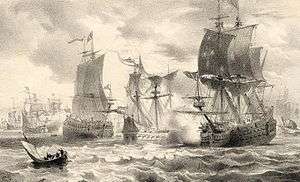Battle of Cape St. Vincent (1641)
| ||||||||||||||||||||||||||||||
The Battle of Cape St Vincent of 1641 took place on 4 November 1641 between a Spanish fleet commanded by Don Juan Alonso de Idiáquez y Robles and a Dutch fleet led by Artus Gijsels during the Eighty Years' War. Two Dutch ships were lost and more than a hundred of their men were killed, but the cost was higher: 2 Spanish ships with over a thousand Spanish dead. The remaining Spanish fleet was forced to abandon the town to the Dutch and retreat to Cádiz.
Background
In 1641, after the outbreak of the Portuguese Restoration War, the Portuguese government, with Dutch and French help, prepared to start the offensive against Spain at sea.[2] Dom António Telles da Silva, who had fought the Dutch in India, was designated commander of squadron of 16 ships, which along of another 30 of the Dutch Republic under Artus Gijsels, was entrusted the mission of capture and hold the Spanish towns of Cádiz and Sanlúcar.[2] The attempts failed thanks to the fortuitous encounter that they had with 5 Dunkirkers under Judocus Peeters, who was chasing a flotilla of Algerian privateers, off Cape St. Vincent.[2] Peeters managed to reach Cádiz without losing a single vessel and put on alert the Marquis of Ayamonte and Don Gaspar Alfonso Pérez de Guzmán, 9th Duke of Medina Sidonia.[3]
Gijsels and Telles returned to Lisbon, where Telles was replaced by Tristão de Mendonça, former Ambassador to the Dutch Republic.[3] The Portuguese fleet then sailed with the French fleet of the Marquis de Brézé,[4] while the Dutch fleet set sail in order to intercept and capture the Spanish West Indies Fleet between the Azores and Cape St. Vincent.[3] It was a hasty maneuver, since the Dutch ships had orders to return to their country if the West Indies Fleet didn't appear before November.[3]
Battle
The Spanish squadron of Galicia, under Don Andrés de Castro, the squadron of Naples, under Don Martín Carlos de Meneos, and the galleons of Don Pedro de Ursúa, were urgently gathered in Cádiz to intercept the Dutch fleet.[3] The military governor of Cádiz, Don Juan Alonso de Idiáquez y Robles, Duke of Ciudad Real, was appointed commander of the fleet in substitution of the Captain General, the Duke of Maqueda, who was ill.[5] He was a veteran soldier, having seen action in the Siege of Leucata against the French, but was unexperienced in sea battles.[5]
Gijsels fleet was sighted off Cape St. Vincent on 4 November. The Duke of Ciudad Real immediately ordered to attack the major Dutch vessels. After suffering severe casualties he stopped the attack and the ships to fall back to Cádiz.[6] This conduct dissatisfied King Philip IV, who severely reprimanded, among other officers, Don Martín Carlos de Mencos, Admiral Don Pedro de Ursúa, and Captains Pedro Girón, Gaspar de Campos and Adrián Pulido.[5]
Michiel de Ruyter was present at this battle as Rear Admiral of the Dutch fleet.
Aftermath
Some of the Dutch ships under Artus Gijsels, abandoned by their Portuguese and French allies, had to sail back to England to make repairs.[5]
References
- 1 2 (Dutch)R. Prud’homme van Reine, Rechterhand van Nederland. Biografie van Michiel Adriaenszoon de Ruyter, p.49
- 1 2 3 Fernández Duro p. 270
- 1 2 3 4 5 Fernández Duro p. 271
- ↑ Saturnino Monteiro, Batalhas e combates da Marinha Portuguesa, Volumes 5-6, p.225. (1997) ISBN 9789725623237
- 1 2 3 4 Fernández Duro p. 272
- ↑ Fernández Duro p. 273
Bibliography
- Cesáreo Fernández Duro: Armada española desde la unión de los reinos de Castilla y de León, Vol. IV. Est. tipográfico Sucesores de Rivadeneyra, Madrid, 1898.
- Antonio Espinosa: Semanario erudito: que comprehende varias obras ineditas de nuestros mejores autores antiguos y modernos. Don Antonio Espinosa, 1790.
- Agustín Ramón Rodríguez González: Victorias por mar de los Españoles, Biblioteca de Historia, Madrid 2006.
- R. Prud’homme van Reine, Rechterhand van Nederland. Biografie van Michiel Adriaenszoon de Ruyter, (Amsterdam 1996)
Coordinates: 37°01′30″N 8°59′40″W / 37.0250°N 8.9944°W
